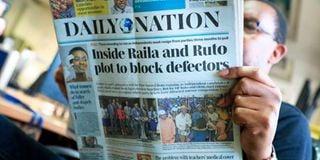Premium
Reader’s guide on how to spot bias in the news of the presidential race

A reader going through Daily Nation Tuesday November 23, 2021 publication.
What you need to know:
- Bias is simply when a news report is slanted to make one side seem more important than it really is.
- Knowing how to identify bias puts you in charge of what you read and how to interpret it.
Tuesday’s Daily Nation front-page, equal-size, side-by-side pictures of William Ruto and Raila Odinga are a perfect example of what in journalism we call equivalency. However, it is a false equivalency. The pictures have little or nothing to do with the story headline, “Inside Raila and Ruto plot to block defectors”, that they are supposed to illustrate.
Dr Ruto is seen, with some governors behind him, standing in front of a lectern. The caption reads: “Deputy President William Ruto addresses journalists at his Karen office yesterday, where he chaired the intergovernmental Budget and Economic Council.”
Mr Odinga is seen in a line of other personalities with a campaign crowd behind them. The caption? “ODM chief Raila Odinga...and West Pokot Governor John Lonyangapuo... join other leaders in a jig with dancers yesterday at Kishaunet grounds in Kapenguria....”
There have been other equivalencies in the Nation, including the particularly telling pairing of other pictures of the two leading presidential race contenders in the front page of the Sunday Nation of November 7.
False equivalency
Equivalency, especially in political reporting, is an attempt to treat major political candidates with sameness, even-handedness or equality. It’s called false equivalency because rarely do politicians have equal weight, significance or value, particularly in newsworthiness. False equivalence may even be misinformation in itself. It could lead readers to believe, for example, that two opposing sides have equal weight, or are of the same magnitude, when they are not.
False equivalency stems from attempts by the media to avoid bias and give politicians an illusion of fairness in coverage. But it creates a bias of its own: Insignificant speeches, fallacies, untruths, deceit, empty promises and so on are given currency over what is significant, true and realisable.
But what is bias? Bias is simply when a news report is slanted to make one side seem more important than it really is. Knowing how to identify bias puts you in charge of what you read and how to interpret it. There are many types, and sources, of bias that you should be aware of. I will isolate only a few for you.
The first type takes us back to where we started: Pictures. The way the media use pictures, including captions and camera angles, can make a political candidate look good or bad, presidential or unpresidential. Pictures heavily influence readers’ perception of candidates or the magnitude of their campaign rallies. They can be used to create bias.
The second is headlines. They are normally written by editors, not the reporters who write the stories. So, does the headline reflect the story? Is it exaggerated or sensational?
Indicators of bias
The third is placement. Where a story is placed in the newspaper influences what a person thinks about its importance. If it is on the front page, it’s thought to be more important than those buried inside. Editors influence what readers think is important by placement. Look at today’s paper.
The fourth is sources. These include not only the people involved in a news story but also pundits, experts and non-experts contacted by the reporter to comment on or explain the news. They could be a source of bias, especially if not carefully selected. So, who are they, and why should we believe what they saying? Are they potentially biased?
Among the other indicators of bias is the use of language. Are the words used extreme and appeal more to emotions than logic? Is there too much oversimplification, overgeneralisation, sensationalism and speculative content? Omission of important or relevant facts, lack of context, unsubstantiated claims, opinion presented as facts and ad hominem attacks are also important indicators of bias.
Always be on the lookout for indicators of bias so that you can figure out whether a story is trying to influence what you think of it. If you can detect bias, you have the power to decide whether you agree with a message or not and avoid being manipulated.
The Public Editor is an independent news ombudsman who handles readers’ complaints on editorial matters including accuracy and journalistic standards. Email: [email protected]. Call or text 0721989264.





